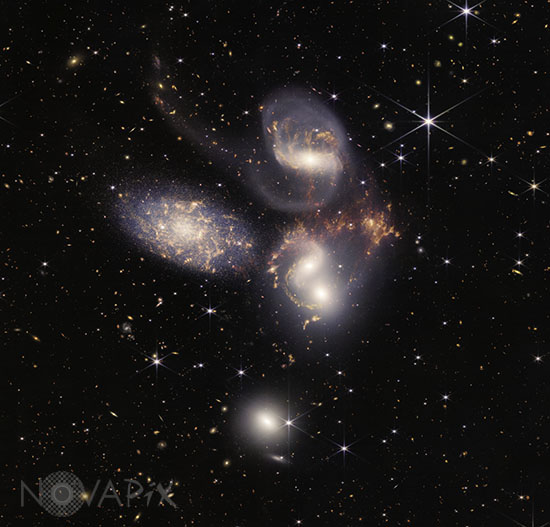Photo Agency - Astronomy - Space - Nature

Stephan's Quintet group of galaxies
author: NASA/ESA/CSA/STSCI/Novapix
reference: a-amg02-00109
Image Size 300 DPI: 107 * 102 cm
An enormous mosaic of Stephanâs Quintet is the largest image to date from NASAâs James Webb Space Telescope, covering about one-fifth of the Moonâs diameter. It contains over 150 million pixels and is constructed from almost 1,000 separate image files. The visual grouping of five galaxies was captured by Webbâs Near-Infrared Camera (NIRCam) and Mid-Infrared Instrument (MIRI).
With its powerful, infrared vision and extremely high spatial resolution, Webb shows never-before-seen details in this galaxy group. Sparkling clusters of millions of young stars and starburst regions of fresh star birth grace the image. Sweeping tails of gas, dust and stars are being pulled from several of the galaxies due to gravitational interactions. Most dramatically, Webbâs MIRI instrument captures huge shock waves as one of the galaxies, NGC 7318B, smashes through the cluster. These regions surrounding the central pair of galaxies are shown in the colors red and gold.
This composite NIRCam-MIRI image uses two of the three MIRI filters to best show and differentiate the hot dust and structure within the galaxy. MIRI sees a distinct difference in color between the dust in the galaxies versus the shock waves between the interacting galaxies. The image processing specialists at the Space Telescope Science Institute in Baltimore opted to highlight that difference by giving MIRI data the distinct yellow and orange colors, in contrast to the blue and white colors assigned to stars at NIRCamâs wavelengths.
Together, the five galaxies of Stephanâs Quintet are also known as the Hickson Compact Group 92 (HCG 92). Although called a âquintet,â only four of the galaxies are truly close together and caught up in a cosmic dance. The fifth and leftmost galaxy, called NGC 7320, is well in the foreground compared with the other four. NGC 7320 resides 40 million light-years from Earth, while the other four galaxies (NGC 7317, NGC 7318A, NGC 7318B, and NGC 7319) are about 290 million light-years away. This is still fairly close in cosmic terms, compared with more distant galaxies billions of light-years away. Studying these relatively nearby galaxies helps scientists better understand structures seen in a much more distant universe.
Contact : Stéphane Aubin +33-(0)9-51-26-53-76
© Novapix - All rights reserved


